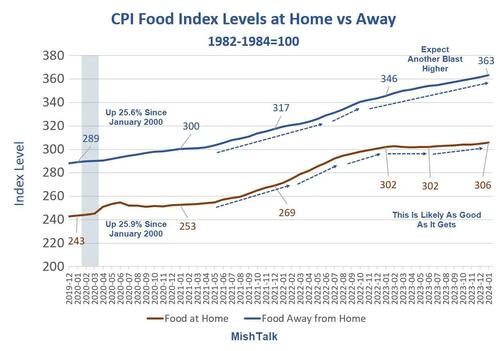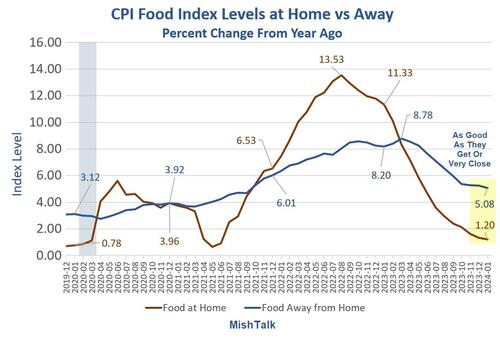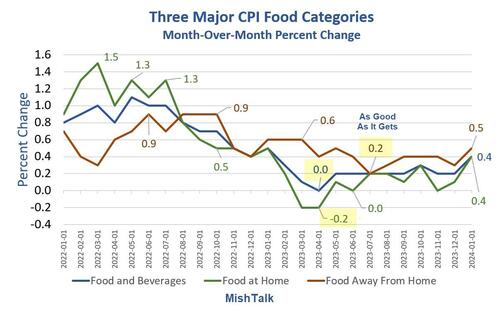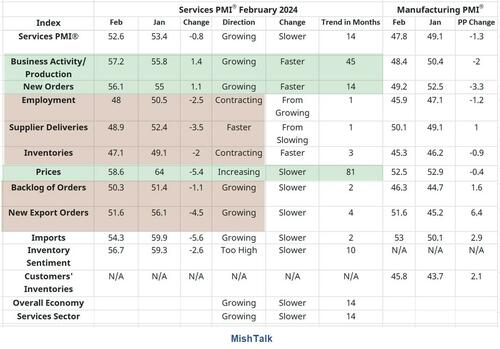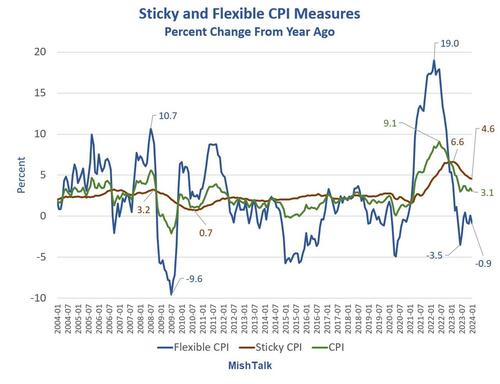Expect Another Surge In Food Prices Fueled By ‘Dynamic Pricing’
 Authored by Mike Shedlock via MishTalk.com
Authored by Mike Shedlock via MishTalk.com
Restaurants are moving towards dynamic menu prices. Expect big surcharges for peak times. Don’t expect off-peak prices to drop much. Labor costs are rising too.
CPI food indexes prices, data from the BLS, chart by Mish
Surge Pricing Is Coming to You
Restaurants are experimenting with surge pricing to deal with peak hours and staffing demand. They like it. You probably won’t.
The Wall Street Journal reports Surge Pricing Is Coming to More Menus Near You
Restaurants like San Diego-based Cali BBQ are experimenting with a form of the dynamic pricing long used by airlines, hotels and ride-hailing services. Technology providers are pitching services that enable restaurants to change prices weekly or monthly, increasing or slashing the cost of a taco or sandwich between a few quarters to several dollars, depending on demand and sales patterns.
Dynamic pricing—charging higher rates at peak times and dropping them at slower ones—has become commonplace in industries such as e-commerce, and mobile apps have made it easier for companies to study consumers’ buying and browsing and quickly adapt. Rising costs in recent years have led more retailers to implement it.
Restaurants are experimenting with the technology as the industry looks for ways to boost sales and increase profits. Many restaurants increased menu prices as labor, food and other costs have soared since 2021.
Wendy’s drew public scrutiny after the burger chain said in a mid-February earnings call that it was looking to test dynamic pricing. The chain said it would invest around $20 million in its U.S. restaurants to install digital menu boards by 2025 that could suggest items to customers and present different offerings depending on the time of day.
Other restaurants, particularly sit-down ones, are charging more for prime seats during peak hours. Gene and Georgetti, a historic Chicago steakhouse where Frank Sinatra once regularly dined, in late 2022 implemented dynamic pricing on two booths frequented by celebrity customers. Diners typically pay a $20 fee when they book the booths at busy hours, helping counterbalance the restaurant’s rising expenses, managing partner Michelle Durpetti said.
While some consumers tend to resent surge pricing, as Wendy’s discovered last month, they like happy-hour discounts and other deals at slow times, industry consultants said.
Discount Pricing
People like discounts. But that’s not how it will work.
Instead, prices will go up across the board. Then to get the discount you will have to go off peak. And so on and so forth.
CPI Food Index Levels at Home vs Away percent change from Year Ago
CPI food prices percent change from a year ago, data from the BLS, chart by Mish
Three Major CPI Food Categories Month-Over-Month
CPI food prices percent change from a year ago, data from the BLS, chart by Mish
Month-over-month food prices have bottomed. Expect food prices to put upward pressure on the CPI.
Cheeseburger Prices Soaring
On March 8, I noted Skyrocketing Costs Driving Cheeseburger Prices Up
In January, 59% of small-business owners reported higher labor costs were their biggest source of inflation, according to a survey of more than 425 entrepreneurs conducted for The Wall Street Journal by Vistage Worldwide, a business-coaching and peer-advisory firm.
Concerns Over inflation and Employment
ISM Services weakened slightly mainly due to a contraction in employment and faster deliveries. Prices remain a concern. The report hints at stagflation.
ISM chart and excerpts below by permission from the Institute for Supply Management® ISM®
On March 5, I noted ISM Services Respondents Share Concerns Over inflation and Employment
Price inflation is notable. Prices are up 81 consecutive months. 58.6 percent of respondents say prices rose in February, That’s down from a whopping 64 percent last month.
The report is a mixed bag that hints at stagflation. It does not suggest imminent rate cuts by the Fed.
70 Percent of the CPI Is Sticky
Some prices change frequently, notably gasoline. Most of the CPI changes infrequently. This post takes a look at the Atlanta Fed Sticky price project.
Sticky and Flexible CPI data from the Atlanta Fed, CPI from the BLS, chart by Mish
On February 26, I noted 70 Percent of the CPI Is Sticky, Including Rent, Insurance, Food Away From Home
The year-over-year weakening of the CPI and the Sticky CPI is partly due the fact that the change in trend is itself sticky. However, the price of gasoline appears to have bottomed and perhaps food prices have too.
If so, some of the benefit of lower year-over-year trend in rent may get chewed up by a rise in flexible CPI components.
Finally, for the next few months, the year-over-year comparisons are a bit harder to beat. So even if the monthly rent measures ease from the 0.40 percent 29 month-over-month trend, there may not be much of an improvement in the year-over-year measures.
We Are Not Over the Rainbow
Let’s check in with former Fed Vice-Chair Alan Blinder and his soft landing thesis.
My Hoot of the Day on February 27 was Alan Blinder’s victory prognosis “The Fed Has Reached the Soft Landing Runway”
Hello Toto (Alan Blinder and Jerome Powell)
The tools that worked in 2003 are not what the Fed can rely on here.
Global wage arbitrage is gone. Just in time manufacturing is gone. Union wage contracts are soaring. Home prices are out of sight.
Demographics require more spending on healthcare with fewer workers contributing to Medicare and Social Security.
And that does not address the Fiscal Cliff that Powell Sees but Blinder doesn’t.
A soft landing is now the consensus estimate. I strongly disagree.
Sourced from ZeroHedge
Image: Pixabay
Become a Patron!
Or support us at SubscribeStar
Donate cryptocurrency HERE
Subscribe to Activist Post for truth, peace, and freedom news. Follow us on SoMee, Telegram, HIVE, Minds, MeWe, Twitter – X, Gab, and What Really Happened.
Provide, Protect and Profit from what’s coming! Get a free issue of Counter Markets today.

